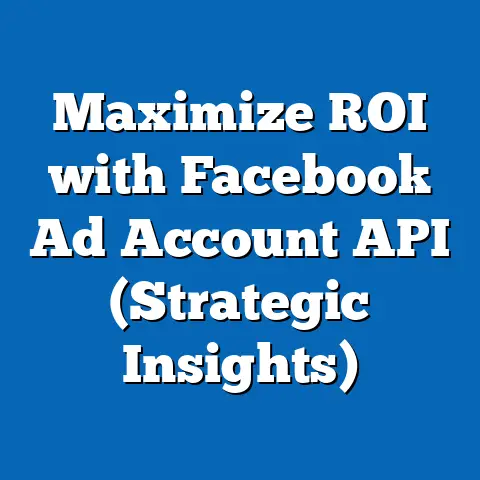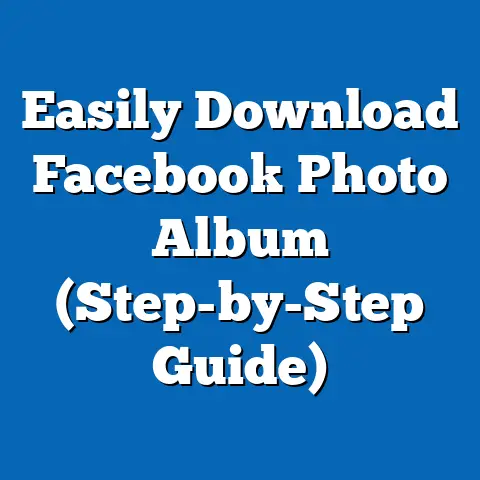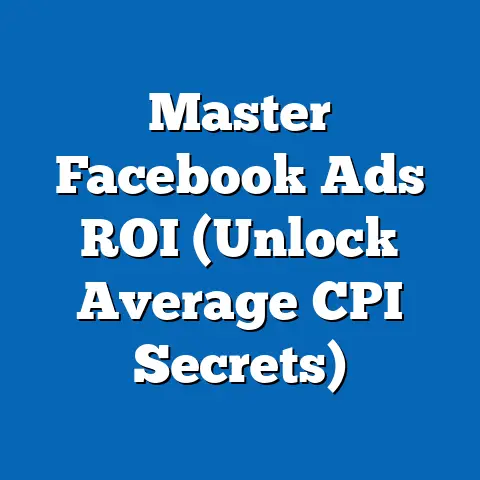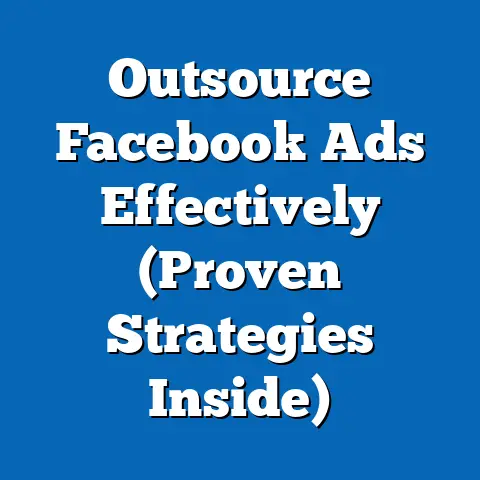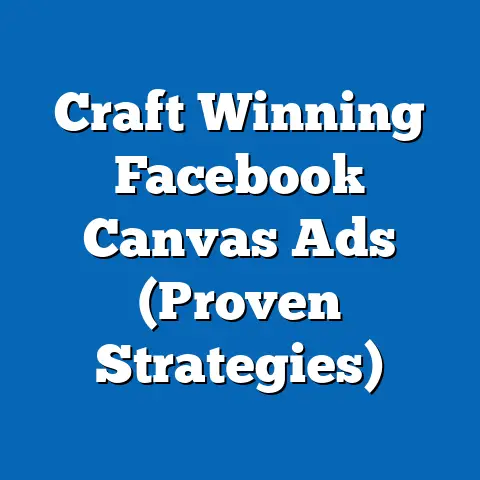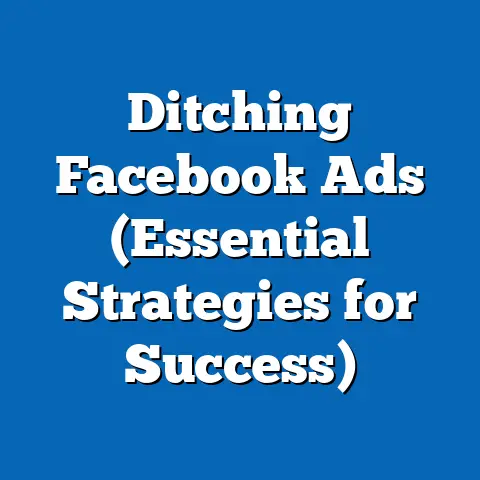Boost Book Sales Through Facebook Ads (Expert Strategies)
Are you an author pouring your heart and soul into crafting compelling stories, only to find your books struggling to reach their intended audience? Do you feel like you’re shouting into the void, yearning for readers to discover the worlds you’ve created? If so, you’re not alone. Many authors face the challenge of book promotion in today’s crowded marketplace. But what if I told you there’s a powerful tool at your fingertips, a digital megaphone that can amplify your voice and connect you with eager readers?
That tool is Facebook advertising.
With billions of active users, Facebook isn’t just a social network; it’s a goldmine for book promotion. I’ve seen firsthand how targeted Facebook ad campaigns can transform an author’s career, turning whispers of interest into a roar of sales. I remember working with a debut novelist who, despite having a fantastic book, was struggling to get traction. We implemented a strategic Facebook ad campaign, carefully targeting readers who enjoyed similar genres, and within weeks, her book climbed the bestseller charts.
This isn’t just about luck; it’s about strategy.
Understanding the Facebook Ads Ecosystem
Before we jump into the nitty-gritty of crafting campaigns, it’s crucial to understand the landscape of Facebook advertising. It’s more than just slapping up a picture and hoping for the best; it’s about strategic placement, precise targeting, and a deep understanding of how Facebook’s algorithms work.
Overview of Facebook Advertising
Facebook ads are paid messages that businesses and individuals can display to users on the Facebook platform. These ads can take various forms, including:
- Image Ads: Simple ads featuring a single image and text.
- Video Ads: Engaging ads that use video to capture attention.
- Carousel Ads: Showcase multiple images or videos in a scrollable format.
- Collection Ads: Ideal for e-commerce, allowing users to browse and purchase products directly from the ad.
- Lead Generation Ads: Collect user information, such as email addresses, directly within the ad.
The power of Facebook advertising lies in its ability to target specific audiences based on a wide range of criteria, including demographics, interests, behaviors, and connections. This granular targeting ensures that your ads are seen by the people most likely to be interested in your book.
I’ve found that many authors underestimate the importance of ad format. For example, a captivating video trailer of your book can often outperform a simple image ad, grabbing attention and conveying the essence of your story in a more engaging way.
Why Choose Facebook Ads for Book Promotion
In a world saturated with marketing options, why should authors choose Facebook ads? Here are a few compelling reasons:
- Massive Reach: Facebook boasts billions of active users, providing unparalleled reach to potential readers.
- Precise Targeting: As mentioned earlier, Facebook’s targeting capabilities are incredibly powerful, allowing you to pinpoint your ideal reader with remarkable accuracy.
- Cost-Effectiveness: Compared to traditional advertising methods, Facebook ads can be incredibly cost-effective, especially when optimized correctly.
- Measurable Results: Facebook Ads Manager provides detailed analytics, allowing you to track your campaign’s performance and make data-driven decisions.
- Flexibility: Facebook offers a wide range of ad formats and campaign objectives, allowing you to tailor your strategy to your specific goals.
I remember reading a statistic that really drove this home: Facebook ads have an average conversion rate of 9.21% across all industries. While book sales might not always reach that peak, the potential is definitely there.
Takeaway: Facebook advertising offers authors a powerful and cost-effective way to reach their target audience and drive book sales. By understanding the different ad formats and targeting options, you can create campaigns that resonate with potential readers and deliver measurable results.
Next Step: Start exploring Facebook Ads Manager and familiarize yourself with the different features and options available.
Defining Your Target Audience
Imagine trying to sell a sci-fi novel to someone who only reads romance. You’d be wasting your time and money, right? That’s why defining your target audience is the foundation of any successful Facebook ad campaign. It’s about understanding who your ideal reader is and crafting ads that speak directly to their interests and needs.
Identifying Your Reader Persona
A reader persona is a fictional representation of your ideal reader, based on research and data about your target audience. It goes beyond simple demographics and delves into their motivations, interests, and behaviors.
Here’s how to create a reader persona:
- Gather Information: Start by gathering information about your existing readers. What are their demographics (age, gender, location)? What are their interests (genres, authors, hobbies)? What are their behaviors (online habits, purchasing patterns)?
- Identify Common Traits: Look for common traits and patterns in your data. Are your readers primarily women aged 25-45 who enjoy fantasy novels and spend time in online book communities?
- Create a Fictional Character: Give your reader persona a name, a face, and a backstory. This will help you visualize them and craft ads that resonate with their specific needs and desires.
For example, let’s say you’ve written a historical fiction novel set in Victorian England. Your reader persona might be “Eleanor,” a 35-year-old librarian who enjoys reading about strong female characters and historical events. She’s a member of several online book clubs and often purchases books based on recommendations from other members.
I once worked with an author who initially thought his target audience was broad, encompassing anyone interested in history. But after creating a detailed reader persona, we realized his ideal reader was specifically interested in the social and political aspects of the era, allowing us to tailor his ads with much more precision.
Utilizing Facebook’s Audience Insights
Facebook Audience Insights is a powerful tool that allows you to analyze the demographics, interests, and behaviors of Facebook users. It’s like having a direct line into the minds of your potential readers.
Here’s how to use it:
- Access Audience Insights: Go to Facebook Ads Manager and select “Audience Insights” from the “Tools” menu.
- Define Your Audience: Start by defining your target audience based on demographics, interests, and behaviors. You can use keywords related to your book’s genre, themes, or target audience.
- Analyze the Data: Audience Insights will provide you with valuable data about your target audience, including their age, gender, location, interests, relationship status, education level, and job titles.
- Refine Your Targeting: Use the data you gather to refine your targeting options in your Facebook ad campaigns.
For example, if you’re writing a thriller novel, you can use Audience Insights to target users who are interested in authors like Gillian Flynn or Paula Hawkins, or who are members of thriller book groups.
I remember being surprised by the data I uncovered using Audience Insights. I discovered that a particular author’s readers were also heavily interested in specific types of documentaries and podcasts, which opened up new avenues for targeting and ad copy.
Takeaway: Defining your target audience is crucial for creating effective Facebook ad campaigns. By creating reader personas and utilizing Facebook Audience Insights, you can pinpoint your ideal reader and craft ads that resonate with their specific interests and needs.
Next Step: Start creating reader personas for your books and explore Facebook Audience Insights to gather data about your target audience.
Crafting Compelling Ad Copy and Visuals
You’ve identified your target audience, now it’s time to grab their attention with compelling ad copy and visuals. Remember, people are scrolling through their feeds at lightning speed, so your ad needs to stand out and immediately capture their interest.
Writing Persuasive Ad Copy
Ad copy is the text that accompanies your ad, and it’s your opportunity to tell potential readers why they should buy your book. Here are some tips for writing persuasive ad copy:
- Start with a Hook: Grab attention with a compelling headline or opening line that speaks to your target audience’s interests or pain points.
- Highlight the Benefits: Focus on the benefits of reading your book, not just the features. What will readers gain from reading it? Will it entertain them, inspire them, or teach them something new?
- Use Emotional Triggers: Tap into your target audience’s emotions by using words and phrases that evoke feelings of excitement, curiosity, or nostalgia.
- Include a Clear Call to Action: Tell readers what you want them to do next. Do you want them to click on your website, buy your book, or join your email list?
For example, instead of saying “My book is a historical fiction novel,” you could say “Escape to Victorian England and unravel a captivating tale of love, betrayal, and intrigue.”
I’ve learned that using social proof in your ad copy can be incredibly effective. Mentioning positive reviews or awards can build trust and credibility. For example: “Readers are calling it ‘the best historical fiction novel of the year!'”
Designing Eye-Catching Visuals
Visuals are just as important as ad copy when it comes to capturing attention. Your images or videos should be high-quality, relevant to your book, and visually appealing.
Here are some tips for designing eye-catching visuals:
- Use High-Quality Images: Avoid blurry or pixelated images. Use professional-quality photos or illustrations that are visually appealing.
- Showcase Your Book Cover: Your book cover is your most important marketing asset. Make sure it’s prominently displayed in your ad.
- Use Author Branding: Include your author logo or branding elements in your ad to build brand recognition.
- Create Video Trailers: Video trailers can be incredibly effective for showcasing your book’s story and characters.
- Test Different Visuals: Experiment with different images and videos to see what resonates best with your target audience.
I’ve found that using images of real people reading your book can be incredibly effective. It creates a sense of connection and makes your book feel more relatable.
Takeaway: Compelling ad copy and eye-catching visuals are essential for capturing attention and driving clicks. By focusing on the benefits of reading your book, using emotional triggers, and creating visually appealing ads, you can increase your chances of success.
Next Step: Start brainstorming ideas for your ad copy and visuals. Experiment with different approaches and see what resonates best with your target audience.
Setting Up Your Facebook Ad Campaign
Now that you have your ad copy and visuals ready, it’s time to set up your Facebook ad campaign. This involves choosing the right campaign objective, setting your budget, and selecting your ad placements.
Choosing the Right Campaign Objective
Facebook offers a variety of campaign objectives, each designed to achieve a specific goal. For book sales, the most relevant objectives are:
- Traffic: Drive traffic to your website or landing page where readers can purchase your book.
- Conversions: Optimize for conversions, such as book purchases or email sign-ups.
- Engagement: Increase engagement with your ad, such as likes, comments, and shares.
- Lead Generation: Collect leads from potential readers who are interested in your book.
The best objective will depend on your specific goals and marketing strategy. If you’re primarily focused on driving sales, the “Conversions” objective is likely the best choice. If you’re trying to build awareness and generate interest, the “Engagement” objective might be more appropriate.
I’ve found that starting with a “Traffic” campaign to test different ad creatives and targeting options can be a good strategy before switching to a “Conversions” campaign. This allows you to gather data and optimize your ads before investing in a more expensive objective.
Budgeting and Bidding Strategies
Setting an appropriate budget is crucial for maximizing your ROI. There’s no one-size-fits-all answer, as the ideal budget will depend on your goals, target audience, and the cost of reaching them.
Here are some tips for budgeting and bidding:
- Start Small: Begin with a small daily budget and gradually increase it as you see results.
- Set a Lifetime Budget: If you have a specific budget in mind, you can set a lifetime budget for your campaign.
- Choose Your Bidding Strategy: Facebook offers different bidding strategies, including automatic bidding and manual bidding. Automatic bidding allows Facebook to optimize your bids for you, while manual bidding gives you more control over your bids.
- Monitor Your Results: Keep a close eye on your campaign’s performance and adjust your budget and bids as needed.
I’ve learned that it’s better to start with a lower budget and gradually increase it as you optimize your campaign. This allows you to test different ad creatives and targeting options without risking a large amount of money.
Ad Placement Options
Facebook offers a variety of ad placements, including:
- Facebook Feed: The most common placement, where ads appear in users’ news feeds.
- Instagram Feed: Ads appear in users’ Instagram feeds.
- Audience Network: Ads appear on websites and apps that are part of Facebook’s Audience Network.
- Messenger: Ads appear in users’ Messenger inboxes.
The best placement will depend on your target audience and the type of ad you’re running. For book sales, the Facebook Feed and Instagram Feed are often the most effective placements.
I’ve found that testing different placements can be a good way to optimize your campaign. You can use Facebook’s split testing feature to compare the performance of different placements and see which ones are delivering the best results.
Takeaway: Setting up your Facebook ad campaign involves choosing the right campaign objective, setting your budget, and selecting your ad placements. By carefully considering these factors, you can create campaigns that are optimized for success.
Next Step: Start setting up your Facebook ad campaign. Experiment with different objectives, budgets, and placements to see what works best for your book.
Monitoring and Optimizing Your Campaign
Setting up your campaign is just the first step. The real magic happens when you start monitoring your results and optimizing your ads for maximum performance. This is where data-driven decision-making comes into play.
Key Metrics to Track
Tracking the right metrics is essential for measuring the success of your Facebook ad campaigns. Here are some key metrics to track:
- Click-Through Rate (CTR): The percentage of people who see your ad and click on it. A high CTR indicates that your ad is resonating with your target audience.
- Conversion Rate: The percentage of people who click on your ad and then complete a desired action, such as purchasing your book or signing up for your email list.
- Cost Per Click (CPC): The amount you pay each time someone clicks on your ad.
- Cost Per Acquisition (CPA): The amount you pay for each conversion, such as a book purchase or email sign-up.
- Return on Ad Spend (ROAS): The amount of revenue you generate for every dollar you spend on advertising.
I’ve found that tracking these metrics on a daily basis is crucial for identifying trends and making timely adjustments to your campaign.
A/B Testing Your Ads
A/B testing, also known as split testing, is the process of comparing two versions of an ad to see which one performs better. This is a powerful way to optimize your ads and improve your results.
Here’s how to conduct A/B tests:
- Choose an Element to Test: Select one element of your ad to test, such as the headline, image, or call to action.
- Create Two Versions: Create two versions of your ad, each with a different variation of the element you’re testing.
- Run Your Test: Run your ads and track the results.
- Analyze the Results: After a sufficient amount of time, analyze the results and see which version of the ad performed better.
- Implement the Winning Version: Implement the winning version of the ad and continue testing other elements.
I’ve learned that testing one element at a time is the best way to isolate the impact of each change. For example, you might test two different headlines to see which one generates a higher CTR.
Takeaway: Monitoring your campaign and A/B testing your ads are essential for maximizing your results. By tracking the right metrics and conducting A/B tests, you can continuously optimize your ads and improve your ROI.
Next Step: Start monitoring your campaign’s performance and conduct A/B tests on different elements of your ads.
Leveraging Retargeting Ads
Imagine someone browsing your book’s page on Amazon but not making a purchase. What if you could show them another ad reminding them about your book, enticing them to come back and buy it? That’s the power of retargeting.
What is Retargeting?
Retargeting is a form of online advertising that allows you to show ads to people who have previously interacted with your website or social media pages. It’s like giving potential readers a gentle nudge, reminding them about your book and encouraging them to take action.
In the context of book sales, retargeting can be incredibly effective for converting interested readers into buyers. By showing ads to people who have visited your book’s page, watched your video trailer, or engaged with your social media posts, you can increase your chances of making a sale.
I’ve seen firsthand how retargeting can significantly boost conversion rates. One author I worked with saw a 30% increase in book sales after implementing a retargeting campaign.
Setting Up Retargeting Campaigns
Setting up a retargeting campaign involves creating custom audiences based on website visits or engagement with previous ads. Here’s how to do it:
- Install the Facebook Pixel: The Facebook Pixel is a snippet of code that you install on your website. It allows Facebook to track the actions that people take on your site, such as visiting your book’s page or adding it to their cart.
- Create Custom Audiences: In Facebook Ads Manager, create custom audiences based on website visits or engagement with previous ads. For example, you can create an audience of people who have visited your book’s page in the past 30 days.
- Create Retargeting Ads: Create retargeting ads that are specifically designed to appeal to people who have already shown interest in your book. For example, you could show them an ad with a special offer or a compelling review.
I’ve found that using different ad copy and visuals for retargeting ads can be effective. For example, you might use a more urgent tone or highlight a limited-time offer to encourage people to take action.
Takeaway: Retargeting is a powerful tool for converting interested readers into buyers. By creating custom audiences and showing targeted ads, you can increase your chances of making a sale.
Next Step: Install the Facebook Pixel on your website and start creating custom audiences for your retargeting campaigns.
Real-Life Case Studies
Let’s take a look at some real-life examples of authors who have successfully used Facebook ads to boost their book sales. These case studies will provide you with valuable insights and inspiration for your own campaigns.
Success Stories
- Author A: A debut novelist in the fantasy genre used Facebook ads to target readers who enjoyed similar authors. She saw a significant increase in book sales and climbed the bestseller charts within weeks. Her key strategy was using a captivating book trailer video as her primary ad creative.
- Author B: A non-fiction author used Facebook ads to target people interested in personal development. He offered a free chapter of his book in exchange for an email sign-up and then retargeted those leads with ads promoting his book. His success came from building an email list through lead generation ads.
- Author C: A historical fiction author used Facebook ads to target people interested in specific historical events. She saw a significant increase in book sales and built a loyal following of readers. Her key strategy was using highly specific targeting based on historical interests.
I’ve noticed that the most successful authors are those who are willing to experiment and adapt their strategies based on the data they gather.
Key Takeaways
- Targeting is Key: The most successful authors are those who have a deep understanding of their target audience and use Facebook’s targeting capabilities to reach them effectively.
- Compelling Creatives: High-quality ad copy and visuals are essential for capturing attention and driving clicks.
- Retargeting Works: Retargeting can significantly boost conversion rates by reminding interested readers about your book.
- Testing is Essential: Continuously testing different ad creatives and targeting options is crucial for optimizing your campaign and improving your results.
Takeaway: These case studies demonstrate the power of Facebook ads for boosting book sales. By learning from these success stories, you can develop your own effective strategies and achieve your marketing goals.
Next Step: Analyze these case studies and identify the strategies that are most relevant to your own books and target audience.
Recap of Expert Strategies
- Define Your Target Audience: Create reader personas and use Facebook Audience Insights to pinpoint your ideal reader.
- Craft Compelling Ad Copy and Visuals: Focus on the benefits of reading your book and use emotional triggers to capture attention.
- Set Up Effective Campaigns: Choose the right campaign objective, set your budget, and select your ad placements.
- Monitor and Optimize Your Results: Track key metrics and conduct A/B tests to continuously improve your campaign.
- Leverage Retargeting Ads: Show targeted ads to people who have previously interacted with your website or social media pages.
Final Thoughts
Remember, Facebook advertising is an ongoing process. It requires experimentation, adaptation, and a willingness to learn from your mistakes. Don’t be afraid to try new things and see what works best for your books and target audience.
I’ve seen firsthand how Facebook ads can transform an author’s career. It’s not just about selling books; it’s about connecting with readers who will appreciate your work and become loyal fans.
Call to Action
Now it’s time to take action. Start implementing the strategies outlined in this guide and see how Facebook ads can boost your book sales. Share your results with the world and inspire other authors to take control of their marketing destiny.
Your story deserves to be heard. Let Facebook ads help you amplify your voice and connect with the readers who are waiting to discover your book.

